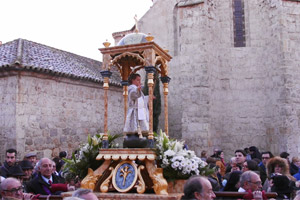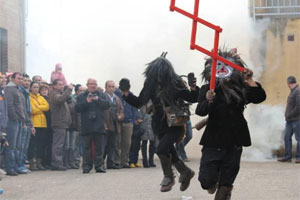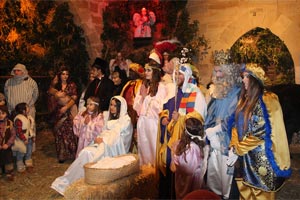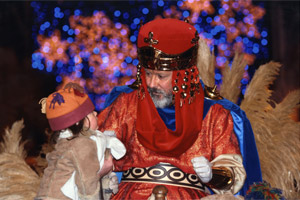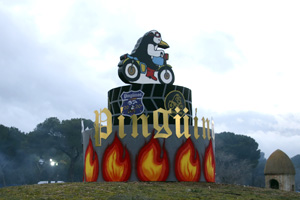Holy Week of Malaga
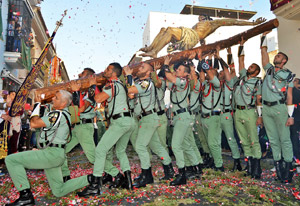
Reasons to experience Semana Santa in Malaga firsthand
There are many reasons why experiencing Semana Santa in Malaga firsthand can be a unique and unforgettable experience.
- Tradition: Semana Santa is one of the most important holidays in Malaga, and the city prepares for it all year round. The tradition and devotion of the Malagueños can be felt in every corner of the city during this time.
- The processions: The processions of Semana Santa in Malaga are spectacular. Each brotherhood has its own procession with its own images and style. The processions are an opportunity to see the most important carvings in the city and to enjoy music and saetas.
- The cuisine: Semana Santa is also an opportunity to enjoy the cuisine of the region. In Malaga, during Semana Santa, you can taste typical dishes such as vigilia stew, cod prepared in different ways, and traditional sweets such as torrijas and pestiños.
- The camaraderie: During Semana Santa, Malaga is filled with visitors and locals who share a common interest in the celebration. The camaraderie and festive atmosphere can be felt in every street and plaza.
- Personal experience: Semana Santa in Malaga is a personal experience. Each person experiences the celebration in a different way, and each one can find their place within the crowd and enjoy the festivity in their own way.
In addition, Malaga has a pleasant climate during Semana Santa, making it an ideal option for those looking to escape the cold and enjoy an unforgettable cultural experience.
Origin and history of Holy Week in Malaga
Holy Week in Malaga is a religious festival celebrated during the week before Easter and has its origins in the Middle Ages. The tradition of Holy Week in Malaga dates back to the 15th century, when the Brotherhood of Holy Charity, the first of many brotherhoods that participate in the city's processions, was founded.
During the 16th and 17th centuries, Holy Week in Malaga began to acquire greater relevance and attract more brotherhoods and devotees. During this period, many of the temples and chapels that are now part of the processions' route were built, such as the Cathedral of Malaga, the Church of Santiago, or the Hermitage of Zamarrilla.
In the 18th century, Holy Week in Malaga experienced a great boom, and many of the thrones and floats that are used today were built, such as those of the Brotherhood of the Expiration, the Brotherhood of the Sepulcher, or the Brotherhood of Sorrows. In addition, during this time, many of the musical pieces that are performed during the processions, such as the procession marches or the saetas, were introduced.
In the 19th century, Holy Week in Malaga went through difficult times due to tensions between different brotherhoods and criticism from some sectors of society. However, in the second half of the century, the festival began to recover thanks to the work of the brotherhoods and devotees.
In the 20th century, Holy Week in Malaga consolidated itself as one of the most important in Spain, and many visitors began to come to the city to enjoy the processions and the festive atmosphere. Today, Holy Week in Malaga remains one of the city's most prominent festivals, with a great variety of brotherhoods and floats, as well as an important musical and gastronomic tradition.
Highlighted processions of Holy Week in Malaga
Holy Week in Malaga features numerous processions, some of which are centuries old, that are considered true works of art and represent one of the city's most important religious and cultural events.
Here are some of the most prominent processions:
Palm Sunday
Procession of La Pollinica: One of the most emblematic processions of Holy Week in Malaga. This procession starts from the Molinillo neighborhood, near the historic center of the city.
Monday of Holy Week
Procession of the Brotherhood of the Captive: One of the most popular and crowded processions of Holy Week in Malaga. The image of Christ the Captive is carried on a golden wooden throne, while the nazarenos (penitents) wear white tunics and green hoods. The procession starts from the church of San Pablo. The departure time is approximately 7:00 pm.
Tuesday of Holy Week
Procession of the Brotherhood of El Rocío: This procession is known for its image of the Virgin of El Rocío, which is carried on a silver throne adorned with white and pink flowers. The nazarenos wear white tunics and green hoods. The procession starts from the church of San Lázaro and goes through the nearby streets, such as Calle Larios and Plaza de la Constitución. The departure time is approximately 6:00 pm.
Wednesday of Holy Week
Procession of the Holy Christ of Blood: The oldest procession of Holy Week in Malaga.
Thursday of Holy Week
Procession of the Brotherhood of Hope: This procession is known for its main image, the Virgin of Hope, which is carried on a silver throne and for its nazarenos dressed in white tunics and green hoods. The procession starts from the church of San Julián and goes through the nearby streets, such as Calle Carretería and Plaza de la Merced. The departure time is approximately 9:00 pm.
Good Friday
Procession of the Brotherhood of the Holy Sepulchre: This procession is known for its main images, the Christ Lying in the Tomb and the Virgin of Solitude, which are carried on silver thrones and for its nazarenos dressed in black tunics and purple hoods. The procession starts from the church of San Juan and goes through the nearby streets, such as Calle Granada and Plaza de la Constitución. The departure time is approximately 6:00 pm.
Easter Sunday
Procession of the Resurrected Christ: The main image is the Resurrected Christ, which is carried on a silver throne by its porteadores (bearers) and nazarenos dressed in white tunics and hoods. The procession starts from the Cathedral of Malaga and goes through the main streets of the historic center of the city, such as Calle Larios and Plaza de la Constitución. The procession is known for its great joy and jubilation, with the band playing festive music and the nazarenos and faithful carrying olive branches as a sign of peace and hope. The departure time is approximately 12:00 pm on Easter Sunday.
How to enjoy Holy Week in Málaga even if you're not very religious
If you're not very religious but still want to enjoy Holy Week in Málaga, there are many ways to do so. You can enjoy the unique atmosphere created in the city during this time, attend cultural events, explore the city's architecture, relax on the beach, or plan a getaway to explore the region's natural beauty. With a variety of options available, there's something for everyone in Málaga during Holy Week.
Whether you decide to immerse yourself in the city's culture or explore the region's natural beauty, you can still enjoy the festive and cheerful atmosphere that fills the streets of Málaga during Holy Week. With pleasant weather and a variety of activities available, it's an ideal destination for those seeking an unforgettable cultural experience, regardless of their religious beliefs.
Must-visit places in the city of Malaga
Malaga is a city with a rich historical and cultural heritage, with a wide variety of must-visit places. Some of the most noteworthy include:
- The Alcazaba: An impressive palace-fortress built in the 11th century during the Muslim era, located in the historic center of the city. It is one of Malaga's most emblematic monuments, with beautiful gardens, courtyards, and towers.
- The Roman Theater: An ancient Roman theater built in the 1st century BC and restored in the 20th century. It is located next to the Alcazaba and is one of the city's main tourist attractions.
- The Cathedral of Malaga: Also known as "La Manquita" (the one-armed lady) due to having one of its towers incomplete, is an impressive temple built between the 16th and 18th centuries. It is located in the heart of the historic center and is one of the most photographed monuments in the city.
- The Picasso Museum: A museum dedicated to Malaga-born artist Pablo Picasso, which houses an impressive collection of more than 200 of his works. It is located in the Buenavista Palace, a beautiful Renaissance building in the historic center of the city.
- The Atarazanas Market: An ancient Arabic-style market built in the 14th century, which has been recently restored and modernized. It is an ideal place to taste typical Malaga cuisine products such as cheeses, cold cuts, seafood, and wines.
- Calle Larios: The main street of the city, with numerous shops, bars, and restaurants. It is an ideal place to stroll and enjoy the lively and cosmopolitan atmosphere of the city.
- The Malaga Park: A large urban park located in the center of the city, which has a wide variety of plants and trees, as well as several fountains and sculptures. It is an ideal place to relax and enjoy nature in the heart of the city.
- The Gibralfaro Castle: An ancient fortress built in the 14th century on top of a hill, from where you can contemplate impressive panoramic views of the city and the Mediterranean Sea.
These are just some of the must-visit places in Malaga, but the city has many other places of interest, such as the port, the Plaza de la Merced, the Episcopal Palace, among others.
Typical Malaga gastronomy that you must try
Malaga's gastronomy is very varied and rich in flavors, and has typical dishes that reflect the culinary tradition of the region. Below are some of the most outstanding dishes:
- Gazpacho: It is a cold soup made with tomato, cucumber, green pepper, onion, and garlic, seasoned with olive oil, vinegar, and salt. It is an ideal meal for hot days in Malaga's summer.
- Ajoblanco: It is a cold soup made with almonds, garlic, olive oil, bread, and vinegar. It is a typical dish from Andalusian cuisine, very refreshing and nutritious.
- Pescaíto frito: It is a mixture of fried fish of different types, such as anchovies, squid, red mullets, and whiting, among others. It is usually served as a tapa or as a main dish accompanied by french fries.
- Espeto de sardinas: It is a traditional way of preparing sardines in Malaga. The sardines are skewered on a cane and grilled with wood embers, which gives them a smoky and very characteristic flavor.
- Porra Antequerana: It is a cold soup very similar to gazpacho but thicker, made with tomato, pepper, bread, garlic, and olive oil. It is usually served as a first course or as an accompaniment to other dishes.
- Plato de los Montes: It is a stew of game meat, such as wild boar, deer, or roe deer, with potatoes, carrots, onions, and spices, which is cooked slowly. It is a hearty and tasty dish, ideal for colder days.
- Boquerones en vinagre: It is a very popular dish in the region, consisting of fresh anchovies marinated in vinegar, olive oil, garlic, and parsley. It is usually served as a tapa or appetizer.
- Puchero: It is a traditional stew made with different types of meat, such as chicken, beef, or pork, together with vegetables and legumes, such as chickpeas, potatoes, carrots, and cabbage. It is a hearty and very complete dish, ideal for winter.
- Chivo al ajillo: It is a stew of marinated goat meat with garlic, bay leaves, oregano, and pepper, which is cooked slowly. It is a typical dish of Malaga's cuisine and very tasty.
- Desserts: In Malaga, you can find a great variety of typical sweets, such as Torrijas, Pestiños, Tortas de aceite, Alfajores, or Roscos de vino. All of them are delicious and can be found in bakeries and confectioneries in the city.

